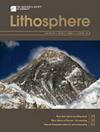The Late Paleocene–Eocene Extension and Differential Denudation in the Eastern Daqingshan Mountains Around the Northeastern Margin of the Ordos Block, Western North China Craton, Constrained by Apatite (U-Th)/He Thermochronology
IF 1.7
4区 地球科学
Q3 GEOCHEMISTRY & GEOPHYSICS
引用次数: 0
Abstract
Abstract The initial timing of extension during the Cenozoic around the northeastern margin of the Ordos Block, western North China Craton (NCC), is still poorly constrained. Apatite (U-Th)/He low-temperature thermochronology was thus applied on eight pre-Cenozoic granitic and gneissic samples transecting the eastern Daqingshan Mountains, northeastern margin of the Ordos Block, to investigate the denudation and cooling event related to the onset of extension therein. Four mean corrected AHe ages in the southern part are overlapped within the standard deviations of 50.0 ± 0.4 to 45.0 ± 8.0 Ma. However, three mean corrected AHe ages in the northern part are prominently older of 99.2 ± 11.0 to 86.6 ± 17.1 Ma, with the rest one of 56.1 ± 8.6 Ma. Altogether, they show a younger-older-younger-older pattern along the transect correlated with the normal faults. AHe thermal history modeling results further demonstrate extensive cooling during the Late Cretaceous but differential cooling during the Late Paleocene–Eocene. The Late Cretaceous extensive cooling in the eastern Daqingshan Mountains, as well as the contemporaneous deposition hiatus in both the eastern Daqingshan Mountains and the Hohhot Depression, together indicates overall denudation in the northeastern margin of the Ordos Block at that time. The Late Paleocene–Eocene differential cooling is probably induced by the tilting of the eastern Daqingshan Mountains as a result of the extension suggested by the distribution of AHe ages. It corresponds to the syn-tectonic subsidence in the Hohhot Depression, indicating a basin-mountain coupling. Regional comparative analysis manifests similar extension around the Ordos Block and more widely across the NCC during the Late Paleocene–Eocene. Temporally, kinematically, and dynamically coupled with this regional extension event, the subduction of the Izanagi-Pacific plate probably plays a major role. However, the contribution of the India-Asia collision could not be ignored.华北克拉通西部鄂尔多斯地块东北缘大青山东部晚古新世-始新世伸展与差异剥蚀:磷灰石(U-Th)/He热年代学约束
华北克拉通西部鄂尔多斯地块东北缘新生代的伸展起始时间尚未明确。应用磷灰石(U-Th)/He低温热年代学方法,对横切鄂尔多斯地块东北缘大青山东部的8个前新生代花岗质和片麻岩样品进行了研究,探讨了与该区伸展开始有关的剥蚀降温事件。南部4个校正后的平均he年龄在50.0±0.4 ~ 45.0±8.0 Ma的标准差范围内重叠。北部3个校正后的平均he年龄明显偏大,为99.2±11.0 ~ 86.6±17.1 Ma,其余3个校正后的平均he年龄为56.1±8.6 Ma。总的来说,它们在与正常断层相关的样带上显示出一个年轻-年老-年轻-年老的模式。热史模拟结果进一步表明,晚白垩世期间存在广泛的冷却,而晚古新世-始新世期间存在差异冷却。大青山东部晚白垩世的大面积降温,以及大青山东部与呼和浩特坳陷同时期的沉积断陷,共同表明了当时鄂尔多斯地块东北缘的整体剥蚀。晚古新世-始新世的差异冷却可能是由于AHe年龄分布表明的伸展导致大青山东部的倾斜所致。它与呼和浩特坳陷的同构造沉降相对应,表明了盆山耦合作用。区域对比分析表明,在晚古新世-始新世期间,以鄂尔多斯地块为中心,在整个北陆构造中也有类似的伸展。在时间上、运动上和动力上,结合这一区域伸展事件,伊扎那吉-太平洋板块的俯冲可能起了主要作用。然而,印亚碰撞的贡献不容忽视。
本文章由计算机程序翻译,如有差异,请以英文原文为准。
求助全文
约1分钟内获得全文
求助全文
来源期刊

Lithosphere
GEOCHEMISTRY & GEOPHYSICS-GEOLOGY
CiteScore
3.80
自引率
16.70%
发文量
284
审稿时长
>12 weeks
期刊介绍:
The open access journal will have an expanded scope covering research in all areas of earth, planetary, and environmental sciences, providing a unique publishing choice for authors in the geoscience community.
 求助内容:
求助内容: 应助结果提醒方式:
应助结果提醒方式:


